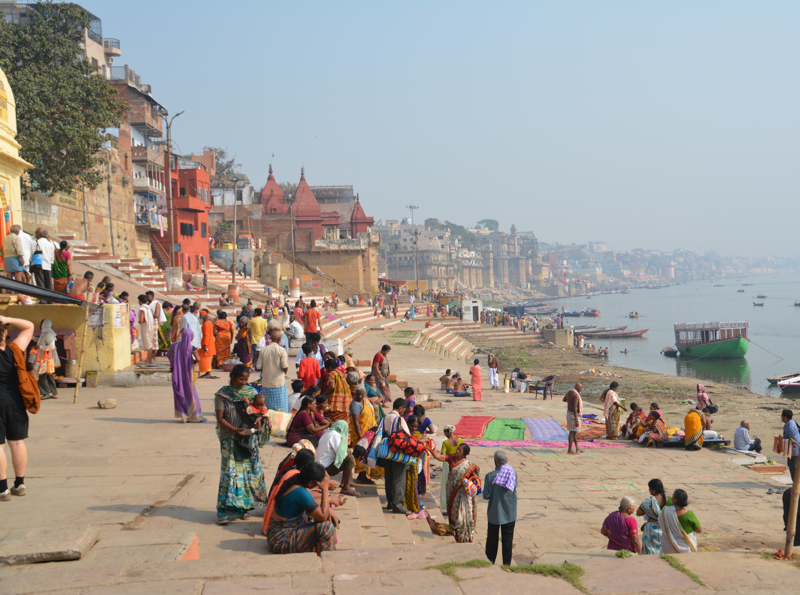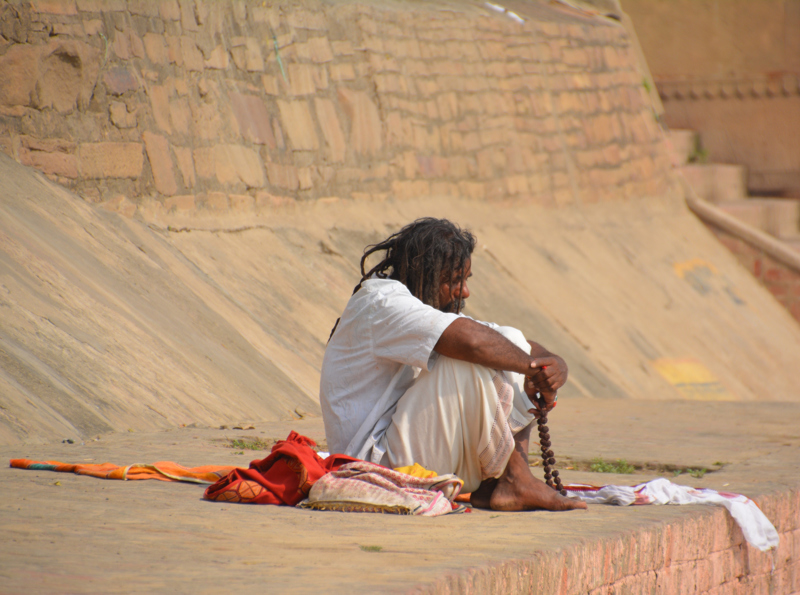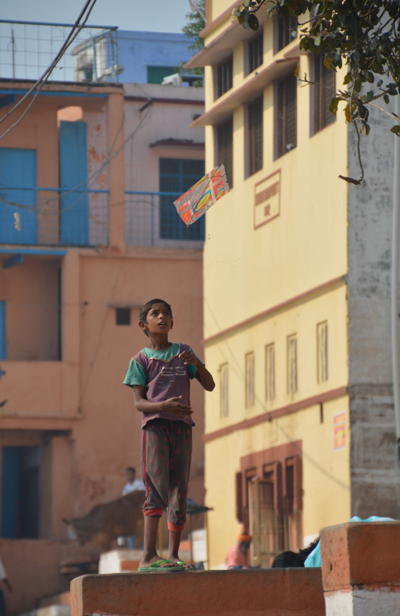India, Europe and Africa 2016
Following a morning's walk in the plantations, playing billiards with some local kids and a look through the tea factory, we headed down country. After a week in the cool climate of the foothills, we were looking forward to some warmth. The idea turned out to be more appealing than the reality and before long we were hanging out for air conditioned train carriages. We met an interesting man on the train who owned a lead acid battery factory in Siliguri. His business was thriving since they had started selling auto rickshaws run on 4 x 12V batteries. He somewhat thwarted my romantic idea about tea plantations, explaining his thoughts on the lack of reinvestment into plantations (for example, low yielding plants over 100yrs old not being replaced), and inability to pay pickers and factory workers what he rightly considered a living wage. Tea pickers in the village we stayed in were paid 125 rupees (equivalent to NZD $2.78) per day. This is considered a minimum wage. But the average wage is 450-500 rupees per day. In his opinion these problems were slowly destroying the tea industry in West Bengal.
We were due to get off the train at 3.00am in Patna to catch a connecting train to Varanasi at 5.00am. I became a bit apprehensive about our plan when he told us we better find a safe place to wait for our train, as Patna was renowned for being unsafe, especially at night. If it weren't for Liam's confidence, I might've stayed right where I was and awoke somewhere in the south of India the next day.
One of the difficulties of travelling on Indian train is that unless you are familiar with the route, there's no easy way of knowing where you are, or when you are arriving at the station you want to get off at. Trains usually only stop for about a minute, so it's a good idea to quickly disembark. We thought we had it sussed as we approached our town, but a group of men who were blocking our way out were convinced we weren't at a station at all, and wouldn't let us through. 60 seconds was looming. Thankfully, the factory owner noticed we hadn't got off the train onto the platform walked alongside the carriages to find us and move the overly confident men out of the way. We were lucky to make the connection as our first train was running 1.5 hours late. It sounds like 3 hours until dawn at the station may have been character building.
Arriving in Varanasi, a tuk tuk dropped us off next to a small alleyway near a guesthouse in the Old city. Stepping into it we entered a maize of small cobbled paths. Lining the paths high buildings sloped in different directions. Monkeys jump roof to roof and cattle sprawl out on the pavement. Goats climb on steps, mounds of stones, and the odd parked scooter. All awhile, there is a constant click clack of ancient silk looms behind wooden doors.
Silk weaving is the dominant manufacturing industry in Varanasi. The looms are foot powered and each take up the size of a small room. It takes 3-4 days to make a silk scarf, weeks to make a sari. Many weavers begin learning around age 5, which understandably is under scrutiny. Every alleyway has numerous small vendors selling silk and pashmina scarves and shawls. Liam thinks he’s lucky I'm not a shopaholic. He may be in for a shock when I get to the land of lapice and turquoise.
You never hear anyone say they were pleasantly surprised by the Ganges. Maybe that’s the only reason I was. It would be misleading to say rubbish, excrement and bodies weren't there, but most of that was going on below the surface. I guess the size of the river swallows up the huge burden of pollution to some extent, and all that really does is make experiencing the river less objectionable. I certainly wouldn't consider a dip, and it does have a mild but distinct smell. The city occupies the West bank of the river. The East side is completely barren, being very prone to flooding. Ghats (steps down to the water) line the banks where people bathe and do laundry. During the day the steps are covered in washing, making for a colourful display in the sun. Who knows why they choose to lay their clothes in the dust, rather than setting up lines to hang them. Ghats used for cremation though on first arrival seem busy and indiscreet, are relatively serene. Water buffalo commonly kept for milking hang out in groups along the river. In general, buffalo seem to be relatively well cared for. We even saw one man oiling their horns and heads. The care of cattle is less consistent. Ironic, we thought, given that cows are such a holy animal in Hindu culture.
Overall I thought being next to the river in Varanasi was beautiful. Liam may have agreed had he not received so much attention from some of the locals out to make or take a dollar. Practice makes perfect though. He’s good at shaking a hand hard enough to leave the recipient wincing, returning every question directly, and making it clear that no matter how much they would love us to go to their friends daughters wedding, we’re not going to meet them later that night to join in the celebrations.
emily.j.buswell
30 chapters
16 Apr 2020
Kurseong to Varanasi
Kurseong
Following a morning's walk in the plantations, playing billiards with some local kids and a look through the tea factory, we headed down country. After a week in the cool climate of the foothills, we were looking forward to some warmth. The idea turned out to be more appealing than the reality and before long we were hanging out for air conditioned train carriages. We met an interesting man on the train who owned a lead acid battery factory in Siliguri. His business was thriving since they had started selling auto rickshaws run on 4 x 12V batteries. He somewhat thwarted my romantic idea about tea plantations, explaining his thoughts on the lack of reinvestment into plantations (for example, low yielding plants over 100yrs old not being replaced), and inability to pay pickers and factory workers what he rightly considered a living wage. Tea pickers in the village we stayed in were paid 125 rupees (equivalent to NZD $2.78) per day. This is considered a minimum wage. But the average wage is 450-500 rupees per day. In his opinion these problems were slowly destroying the tea industry in West Bengal.
We were due to get off the train at 3.00am in Patna to catch a connecting train to Varanasi at 5.00am. I became a bit apprehensive about our plan when he told us we better find a safe place to wait for our train, as Patna was renowned for being unsafe, especially at night. If it weren't for Liam's confidence, I might've stayed right where I was and awoke somewhere in the south of India the next day.
One of the difficulties of travelling on Indian train is that unless you are familiar with the route, there's no easy way of knowing where you are, or when you are arriving at the station you want to get off at. Trains usually only stop for about a minute, so it's a good idea to quickly disembark. We thought we had it sussed as we approached our town, but a group of men who were blocking our way out were convinced we weren't at a station at all, and wouldn't let us through. 60 seconds was looming. Thankfully, the factory owner noticed we hadn't got off the train onto the platform walked alongside the carriages to find us and move the overly confident men out of the way. We were lucky to make the connection as our first train was running 1.5 hours late. It sounds like 3 hours until dawn at the station may have been character building.
Arriving in Varanasi, a tuk tuk dropped us off next to a small alleyway near a guesthouse in the Old city. Stepping into it we entered a maize of small cobbled paths. Lining the paths high buildings sloped in different directions. Monkeys jump roof to roof and cattle sprawl out on the pavement. Goats climb on steps, mounds of stones, and the odd parked scooter. All awhile, there is a constant click clack of ancient silk looms behind wooden doors.
Silk weaving is the dominant manufacturing industry in Varanasi. The looms are foot powered and each take up the size of a small room. It takes 3-4 days to make a silk scarf, weeks to make a sari. Many weavers begin learning around age 5, which understandably is under scrutiny. Every alleyway has numerous small vendors selling silk and pashmina scarves and shawls. Liam thinks he’s lucky I'm not a shopaholic. He may be in for a shock when I get to the land of lapice and turquoise.
You never hear anyone say they were pleasantly surprised by the Ganges. Maybe that’s the only reason I was. It would be misleading to say rubbish, excrement and bodies weren't there, but most of that was going on below the surface. I guess the size of the river swallows up the huge burden of pollution to some extent, and all that really does is make experiencing the river less objectionable. I certainly wouldn't consider a dip, and it does have a mild but distinct smell. The city occupies the West bank of the river. The East side is completely barren, being very prone to flooding. Ghats (steps down to the water) line the banks where people bathe and do laundry. During the day the steps are covered in washing, making for a colourful display in the sun. Who knows why they choose to lay their clothes in the dust, rather than setting up lines to hang them. Ghats used for cremation though on first arrival seem busy and indiscreet, are relatively serene. Water buffalo commonly kept for milking hang out in groups along the river. In general, buffalo seem to be relatively well cared for. We even saw one man oiling their horns and heads. The care of cattle is less consistent. Ironic, we thought, given that cows are such a holy animal in Hindu culture.
Overall I thought being next to the river in Varanasi was beautiful. Liam may have agreed had he not received so much attention from some of the locals out to make or take a dollar. Practice makes perfect though. He’s good at shaking a hand hard enough to leave the recipient wincing, returning every question directly, and making it clear that no matter how much they would love us to go to their friends daughters wedding, we’re not going to meet them later that night to join in the celebrations.



1.
Kolkata to Darjeeling
2.
Darjeeling
3.
Darjeeling to Kurseong
4.
Kurseong to Varanasi
5.
Varanasi to Khajuraho
6.
Khajuraho to Agra
7.
Agra to Jaipur
8.
Jaipur to Pushkar
9.
Pushkar to Bundi
10.
Bundi to Jodhpur
11.
Jodhpur to Jaisalmer
12.
Jaisalmer to Delhi
13.
Delhi to London
14.
London to Waterford
15.
Waterford to Tralee
16.
Tralee to Westport
17.
Westport to Mullingar
18.
Mullingar to Donegal
19.
Donegal to Belfast
20.
Belfast to Dublin
21.
Dublin to Berlin
22.
Berlin to Marburg
23.
Marburg to Munich
24.
Munich to Salzburg
25.
Salzburg to Ljubljana
26.
Ljubilana to Lake Bled and Postojna
27.
Postojna to Croatia part one
28.
Croatia to Bosnia-Hercegovina
29.
Bosnia to Croatia part 2
30.
Croatia to Italy